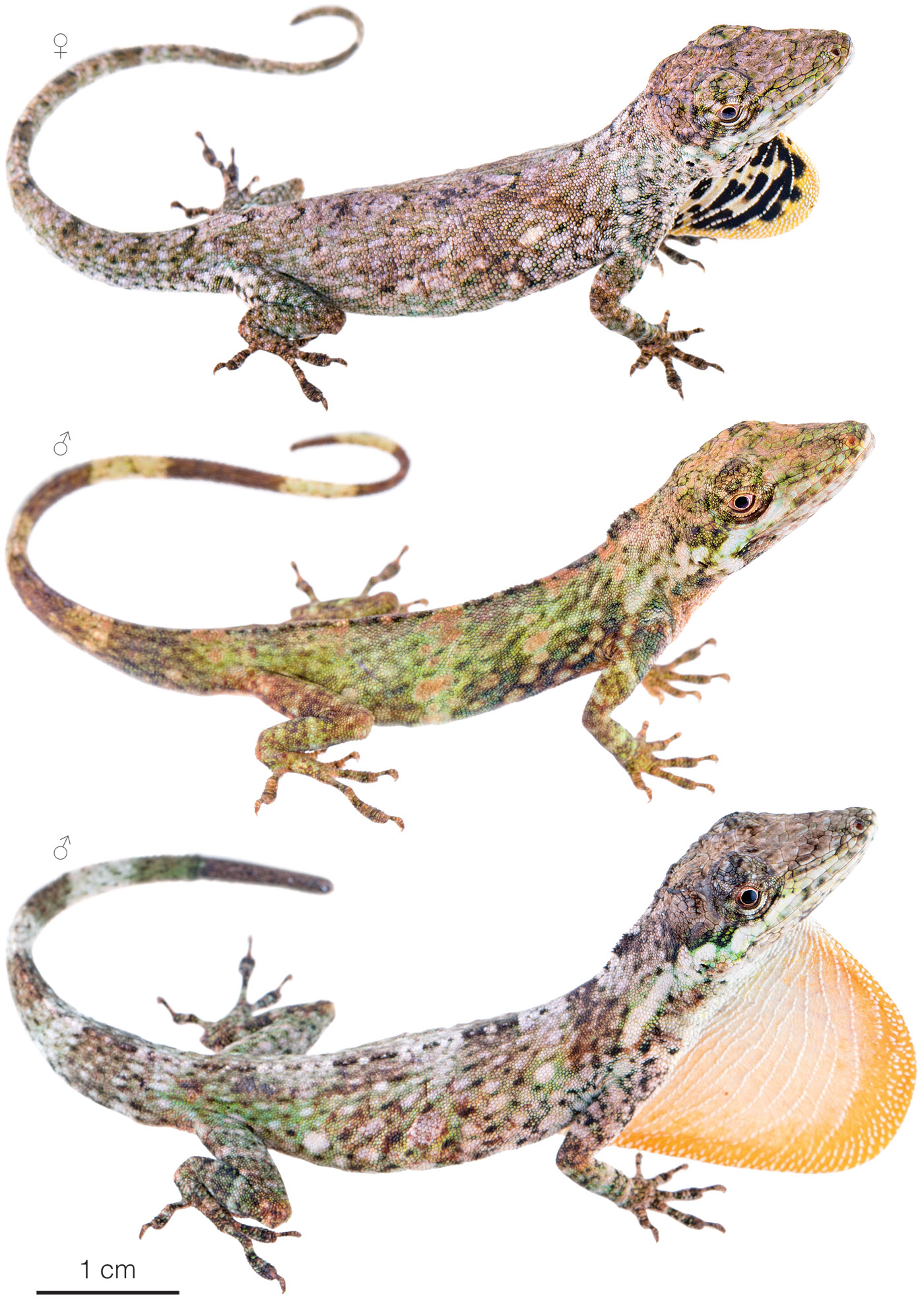Published July 2, 2023. Updated November 10, 2023. Open access. | Purchase book ❯ |
Williams-Mittermeier Anole (Anolis williamsmittermeierorum)
Reptiles of Ecuador | Sauria | Anolidae | Anolis williamsmittermeierorum
English common name: Williams-Mittermeier Anole.
Spanish common name: Anolis andino de Williams-Mittermeier.
Recognition: ♂♂ 13.8 cmMaximum distance from the snout to the tip of the tail. Snout–vent length=6.0 cm. ♀♀ 15.1 cmMaximum distance from the snout to the tip of the tail. Snout–vent length=6.6 cm..1 Anoles are easily distinguishable from other lizards by their diurnal habits, extensible dewlap in males (can be present in females also), expanded digital pads, and granular scales on the dorsum and belly. The Williams-Mittermeier Anole (Anolis williamsmittermeierorum) can be identified from other co-occurring anoles based on its small body size, short tail (about 1.3x SVL), short limbs, smooth head scales, and its dewlap coloration.1,2 In males, the dewlap is tan with a light peach edge; in females, it is light peach with black blotches (Fig. 1).In eastern Ecuador, the anole species that most resembles A. williamsmittermeierorum in size and coloration is A. lososi, but males of this species have a white dewlap and females have a yellow dewlap with black spots.1,3

Figure 1: Individuals of Anolis williamsmittermeierorum from Plan de Milagro, Morona Santiago province, Ecuador. j=juvenile.
Natural history: Anolis williamsmittermeierorum is a rarely seen diurnal and arboreal lizard that inhabits the understory and canopy of old-growth to moderately disturbed cloud forests, roadside vegetation, and forest remnants along creeks.1,2,4 Most individuals of this species have been found at night, roosting on twigs, ferns, and narrow leaves 1–8 m above the ground.1,2,4 These anoles are included in the “twig” anole guild because of their comparatively small SVL (~6 cm snout-vent-length), short weakly prehensile tail (≤1.5 SVL), and very short legs (0.5 SVL). Like other phenacosaur anoles, their movements are like those of a chameleon. When disturbed, Williams-Mittermeier Anoles do not drop from their perches but rather hold on more tightly, as in other ‘twig’ anoles.2
Conservation: Data Deficient There is inadequate information to make an assessment of extinction risk..5 Anolis williamsmittermeierorum is included in the DD category because there is inadequate information to make an assessment of its extinction risk based on its scarce distribution data. The species is only from two localities separated from each other by areas having adequate cloud forest cover, suggesting it might be present elsewhere.
Distribution: Anolis williamsmittermeierorum is native to the Amazonian slopes of the Andes of southeastern Ecuador (Fig. 2) and northern Perú.

Figure 2: Distribution of Anolis williamsmittermeierorum in Ecuador.
Etymology: The generic name Anolis is thought to have originated from Cariban languages, specifically from the word anoli, which is the name Arawak peoples may have used to refer to this group of lizards.6 The specific epithet williamsmittermeierorum honors American herpetologists Ernest Williams and Russell Mittermeier, co-discoverers of this species.2
See it in the wild: Anolis williamsmittermeierorum ranks among Ecuador’s most elusive lizard species. Within the country, this species has been documented in a solitary, severely deforested location. Detecting these anoles poses a considerable challenge, primarily attributed to their small size and preference for arboreal perches. At night, slumbering anoles become more conspicuous, as they tend to roost on vegetation. Their bright white bellies can be readily illuminated in the darkness by shining a light upon them, facilitating their finding.
Author: Alejandro ArteagaaAffiliation: Fundación Khamai, Reserva Arlequín, Ecoruta Paseo del Quinde km 56, Santa Rosa de Mindo, Pichincha 171202, Ecuador.
Photographer: Jose VieirabAffiliation: Tropical Herping (TH), Quito, Ecuador.,cAffiliation: ExSitu, Quito, Ecuador.
How to cite? Arteaga A (2023) Williams-Mittermeier Anole (Anolis williamsmittermeierorum). In: Arteaga A, Bustamante L, Vieira J (Eds) Reptiles of Ecuador: Life in the middle of the world. Available from: www.reptilesofecuador.com. DOI: 10.47051/ULIL8045
Literature cited:
- Torres-Carvajal O, Ayala-Varela FP, Lobos SE, Poe S, Narváez AE (2017) Two new Andean species of Anolis lizard (Iguanidae: Dactyloinae) from southern Ecuador. Journal of Natural History 52: 1067–1089. DOI: 10.1080/00222933.2017.1391343
- Poe S, Yañez-Miranda C (2007) A new species of phenacosaur Anolis from Peru. Herpetologica 63: 219–223. DOI: 10.1655/0018-0831(2007)63[219:ANSOPA]2.0.CO;2
- Poe S, Latella I, Ayala-Varela F, Yañez-Miranda C, Torres-Carvajal O (2015) A new species of phenacosaur Anolis (Squamata; Iguanidae) from Peru and a comprehensive phylogeny of Dactyloa-clade Anolis based on new DNA sequences and morphology. Copeia 103: 639–650. DOI: 10.1643/CH-14-127
- Field notes, Reptiles of Ecuador book project.
- Perez J, Lehr E (2019) Anolis williamsmittermeierorum. The IUCN Red List of threatened species. Available from: www.iucnredlist.org. DOI: 10.2305/IUCN.UK.2019-2.RLTS.T48279888A48279901.en
- Allsopp R (1996) Dictionary of Caribbean English Usage. Oxford University Press, Oxford, 776 pp.